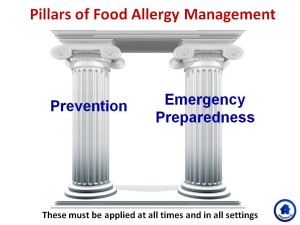Written by Michael Pistiner, MD, MMSc
Faster than a speeding bullet
 Superman is the epitome of health: able to leap over tall buildings in a single bound, more powerful than a locomotive. Much like many of our children, superman is seemingly invincible. And, much like children with food allergy and other causes of anaphylaxis, Superman is weakened and in danger with even the smallest amount of a substance that is harmless to most. In his case, Kryptonite and in theirs, an allergen.
Superman is the epitome of health: able to leap over tall buildings in a single bound, more powerful than a locomotive. Much like many of our children, superman is seemingly invincible. And, much like children with food allergy and other causes of anaphylaxis, Superman is weakened and in danger with even the smallest amount of a substance that is harmless to most. In his case, Kryptonite and in theirs, an allergen.
How can it be? It’s just a food allergy.
For some, this idea of going from perfect health to a life threatening reaction is a very difficult concept to accept. It can sometimes be hard for parents to look at their healthy, active child and imagine that they could ever be sickened, let alone experience a life threatening reaction (anaphylaxis) to a food. When past reactions have been severe though, all it takes is once and the reality sinks in hard and fast. A family’s surrounding community may take a bit of education to “get it.” When the people that parents rely on have a difficult time accepting the reality of a food allergy, it can make our job as parents very challenging. We need secondary care providers: babysitters, relatives, coaches, etc., to implement the very same avoidance strategies that we do when they care for our children. It takes effort for us to get them on the same page. It can be dangerous if we compromise food allergy management for even a moment.
Food Allergies Bring Change
 Having a child with a food allergy means that we need to modify our behavior. At times we need to call attention to ourselves when we may not want to. For example, in a restaurant when we need to ask to speak to the manager and chef, or before school starts when we set up meetings with the school nurse. We must bring auto-injectors with us everywhere and at times restrict foods. Sometimes it may feel like it is going against the grain. At times we may need to be the ones to administer an auto-injector into our own child’s thigh. These are all things that many of us wouldn’t be doing unless we had to.
Having a child with a food allergy means that we need to modify our behavior. At times we need to call attention to ourselves when we may not want to. For example, in a restaurant when we need to ask to speak to the manager and chef, or before school starts when we set up meetings with the school nurse. We must bring auto-injectors with us everywhere and at times restrict foods. Sometimes it may feel like it is going against the grain. At times we may need to be the ones to administer an auto-injector into our own child’s thigh. These are all things that many of us wouldn’t be doing unless we had to.
It takes food allergy education
When people perceive certain situations as being less risky than others, they may not implement appropriate food allergy management. If caregivers do not have the opportunity to learn the basics, such as how to read a label, the importance of epinephrine, or how to give an auto injector, it will be impossible for them to do what they need to do. Access to allergists can be problematic in some areas, with few physicians and long wait times. Sometimes, primary care providers and emergency department doctors may not have the time or awareness of the importance of prevention and preparedness strategies so this teaching may not happen.
Bringing health to patients and families with food allergies
For healthcare providers, ensuring our patients’ health may be more complicated than just delivering basic medical care (diagnosing food allergy and anaphylaxis, prescribing auto-injectors, etc). Other factors that play a huge role in management of food allergic patients must be considered and addressed, especially behavior and social circumstances. This is the case in many chronic diseases (diabetes, asthma, obesity, high blood pressure, etc.). Behavioral and social contributors play major roles in a patient’s health. (McGiniss et. al. The Case for More Active Policy Attention to Health Promotion. Health affairs. 2002). This is clearly seen with managing food allergies.
Behavior clearly plays a role in adolescents and young adults with food allergies. They are the highest risk age group for food allergy related deaths. Risk taking behavior (Sampson et. al. Risk-taking and Coping Strategies of Young Adults with Food Allergies. JACI, 2006) may play a major role in this increased mortality in this age group as a result of social pressures and compromised decision making. Doctors and other healthcare providers must encourage behaviors that decrease risk and prevent accidental exposures. We must also take our patients and families’ social situations into consideration when educating about food allergy management.
Social media can extend the reach of food allergy providers
Healthcare providers see our patients for a very small percentage of their lives, no more than a few hours over the course of a year. The time that we are face to face truly needs to be optimized. Another way we can help families modify behavior is to extend our reach and have more contact points with the families that we serve. The internet can be a great resource for this. Using online teaching tools can help give the families an awareness to help them modify behavior. The addition of social media and an online community can take it a step further. Countless parents are discovering that they are not alone. With the support of these new communities, making the behavioral change, and managing food allergies in all settings isn’t quite so isolating or difficult.
With great power comes great responsibility
Using social media and blogging is an amazing way to share what we have learned so other individuals and families don’t need to face the same challenges and feel overwhelmed. It’s an amazing thing to be able to write for and lend support to an immediate audience of thousands. There are so many that rely so heavily on social media as a primary source of their health information. And for all of us that are using this venue to share and to educate, whether it be patient, parent, nurse, or doctor, it so important for us to be meticulous in fact checking and to be careful in the messages that we deliver. We all must take this seriously when lives may depend on it.
Where do you get your food allergy management information?
Before leaving this blog please drop a comment below sharing where you get the majority of your information about food allergy management. Is it your healthcare providers or is it from social media or the internet?

I feel that we don’t get enough time to go over the real daily management of food allergies with the allergist. We have five different life threatening food allergies and celiac disease in our home. If it wasn’t for well respected food allergy sites and connections to other families with food allergies, I wouldn’t feel confident in my management strategies. I do feel that advice on meeting the nutritional needs of children with multiple allergies is lacking and insurance coverage for nutritional counseling is often lacking.
Thank you! Thank you! I loved your Superman and Kryptonite analogy. As a parent of children with food allergies I ask myself all the time, “how can this be, how can food can be deadly (their Kryptonite) in a matter of moments?” I have learned the basics from our Pediatric Allergist and the rest has been through thorough research on my own part. Reading books on the subject, joining and supporting many allergy related organizations, participating in webinars, firsthand lessons, and interacting on social media support groups. I would agree that people certainly need to exercise caution when obtaining advice online, but if you have a solid foundation of basic information, the additional resources of these support groups is phenomenal. These are people who are dealing with the same problems and have the same questions and frustrations. Some of us are armed with more facts and information than most MD’s. But, again, always exercise caution, especially when the lives of our little superheroes depends on it.
It was trial and error with due diligence 24 years ago to try and manage food allergies. Social media didn’t exist. Education on food allergies was minimal. Ingredients didn’t have to be listed under 2% and it was believed no one could have a reaction with such a minute amount. Treatment was unclear. We’ve come along way with tools, education, and a better understanding of food allergy management. Trial and error with due diligence should now be extinct!
I’ve spent more time on websites than in doctor offices! I’ve taken my time to get more knowledgeable so I can correctly inform others (family, friends, school, AND primary doctors!, and even allergists,) since many only have book knowledge not real life knowledge! Many have never had their own adrenaline over take personal judgement @ the time when their own child is going through a severe allergic reaction. They haven’t had their entire body freeze in fear then shake as they make difficult decisions as to “what steps to take” at the moment anaphylaxis hits! My body shook so much as I tried the first time I watched in fear as my 1yr old suffered an accidental ingestion of milk, that I couldn’t hold a phone & it flipped out of my hands 3 times before trying to dial for help! I pulled off the wrong end of the old Epi pen that wasn’t meant to pull off so no medicine actually administered! So, without the social media providing me with knowledge, I couldn’t validate my experiences to everyone else. Thanks social media & valid websites that help educate me, as a parent & now advocate for food allergies!
We get all of our official information and protocol from our doctors. Second from social media and the internet. There is so much info out there, but when in doubt I always ask our doctors. Some of that information may conflict. We’ve been handling food allergies since our oldest was just a baby, so about 7 years. You learn a lot that first year, from anywhere you can!
We receive all of our info from our extremely thorough, and extremely dedicated allergist. He too, has a kiddo with a life- threatening food allergy and he is on a mission to spread his wealth of knowledge! We are so thankful for him!